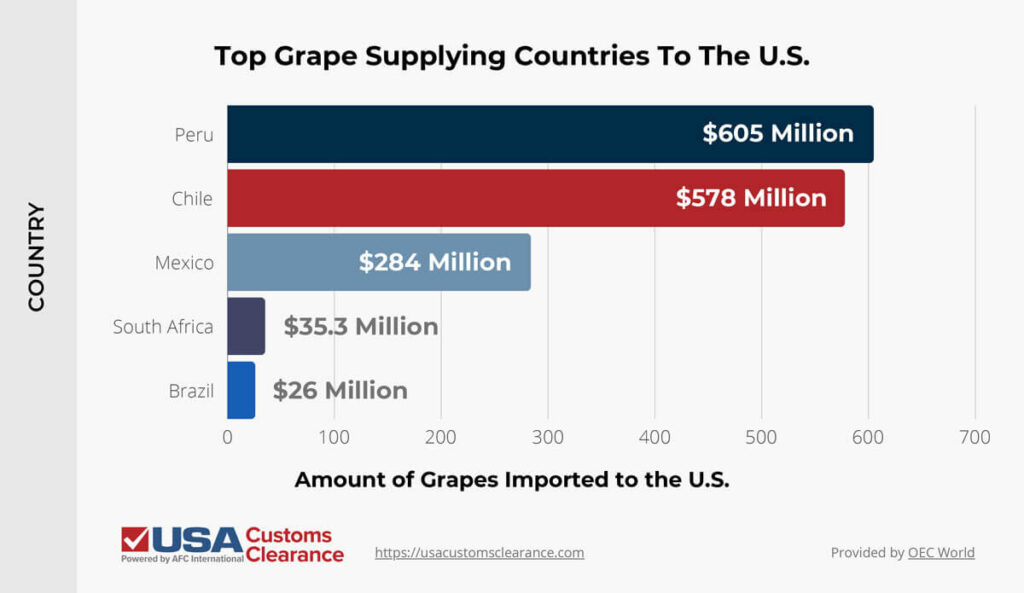
Table grapes are a staple in many households. These big, plump grapes are a delicious, perfect snack for those craving something sweet and fruity. If you want to get these products into the country, you’ll need to complete a few requirements.
Key takeaways:
I’ll guide you through the regulations you need to know when importing table grapes.
You can source your grapes from a variety of countries. However, the U.S. imports the majority of these agricultural products from a few countries in particular. I’ve given you some data on the top nations the U.S. sources from.

Each of these countries produces quality grape products that you can purchase and resell.
However, the top three have an added benefit.
Peru, Chile, and Mexico all share their own FTAs with the United States. Each one provides preferential tariff treatment for grapes. This will help you reduce the costs you’ll incur when you bring these products into the country. I’ve listed each country and the applicable FTAs they participate in with the United States.
While the U.S. imports grapes from South Africa and Brazil considerably less, they still provide quality variants of this agricultural product.
Let’s go over some specifics for the top countries to give you an idea of their productivity.
Peru
As of 2023, there are more than 35,000 hectares in Peru dedicated to the growth of table grapes, and this number is on the rise.
Certain areas in Peru that are known for growing excellent products include:
The locations listed have dry weather and sandy soil, along with a good supply of freshwater. As a result, they have the perfect conditions for a wide variety of grapes.
Chile
Chile is another nation that produces a variety of high quality grapes. Like Peru, there are many regions of the country that grow these goods in large quantities.
The U.S. is the primary destination for Chilean grape exports, which means you can expect to find a supplier that already has experience shipping goods to North America. This can make the importing process much smoother.
Mexico
Between 2018 and 2022, Mexico produced an average of 467,000 tons of grapes. Mexican grapes are known for being very flavorful. The country is also a vital ally that engages in trade with the U.S. on a regular basis.
Thanks to the shared land border between the U.S. and Mexico, timing the imports is a little easier. Since grapes only stay fresh for so long, the country can be a great source for fruit that may need to travel a little further than average.
The United States Department of Agriculture (USDA) and the Food and Drug Administration (FDA) are the main agencies that regulate grape imports. There are some requirements from Customs and Border Protection (CBP) you’ll also be responsible for satisfying, but their rules are more limited.
I’ll give you a rundown on each agency's requirements so you’ll know what to do.
USDA will inspect grape imports entering the country, except for a few varieties. They will be inspected to determine if the goods meet the USDA’s minimum grade, size, and maturity regulations.
The U.S. Standard for Grades of Table Grapes outlines two key requirements, one of which you’ll need to satisfy. You can either abide by the rules set by U.S. No.1 Table Grade or U.S. No.1 Institutional grade. I’ve provided the stipulations for each one.
Products subject to the U.S. Standards for Grades of Table Grapes will need to meet one of these two requirements when imported between April 10th and July 10th each year.
These requirements will apply to Perlette grapes, except the minimum berry size should be ten-sixteenths of an inch or 1.59 cm. Flame Seedless grapes are subject to the same berry size rule, but you must also specify their maturity.
A Flame Seedless grape is considered mature if its juice has at least 15% soluble solids that are equal to or in excess of 20 parts to every part acid.
Keep in mind that a few grape varieties are excluded from the USDA rules for importing table grapes.
The USDA will need you to provide different documents to import these varieties of grapes. First, you’ll need a certification that proves your goods have been thoroughly inspected. This is done by the Federal or Federal-State Inspection Program.
When importing grapes that are exempt from the U.S. Standards for Grades of Table Grapes, you’ll need to provide an Importer’s Exempt Commodity Form (SC-6). This document can also be used if you plan to divert your products for commercial processing into juice products.
In the event your grapes fail FSIS inspection, one of four things can happen:
You should make arrangements for inspection and certification at least one day before your grapes arrive at a port.
The FDA has rules for importing human foods that you’ll need to satisfy when bringing grapes into the country. You’ll be expected to complete a few different requirements.
There’s a good chance the grapes you’re importing come from a facility that either manufactures, processes, packs, receives or holds food. You’ll need to get this facility registered with the FDA if they haven’t been already.
Raw fruits, including grapes, are exempt from the FDAs nutritional labeling requirements. However, you will need to provide one for your products if they’ve been processed in some way. For example, grapes that are frozen will be considered processed and require a label.
Your grapes will still be subject to other mandatory labeling requirements. Any information that appears on it should be truthful and be in English or the language of the U.S. territory it is sent to. For example, if you are sending the grapes to the commonwealth of Puerto Rico, the label can be in Spanish.
Labels should provide the following information:
Under the FSVP, you’ll have the responsibility of verifying if the foreign supplier of your grapes has preventive controls in place to ensure the safety of your food. This will require you to complete four main steps.
Finally, the FDA will want you to send them a prior notice before your goods enter the country. You can submit it through CBP’s Automated Commercial Environment (ACE). Another option is to submit this document through the Prior Notice System Interface (PNSI).
Related: The Complete Guide To FDA Customs
When it comes to importing grapes, CBP is primarily concerned with receiving the necessary documents to import your goods.
These are just a few of the common pieces of paperwork, but you may need additional documents depending on the specifics of your shipment.
Overcoming FDA grape regulations can be easy when you have a reliable partner at your side. At USA Customs Clearance, we have a team of Licensed Customs Brokers that are ready to assist you with importing your grapes. We can also help with a variety of services that will make bringing your goods into the country much easier.
This includes:
Start importing grapes today with USA Customs Clearance by your side. You can use one of our services by contacting us through the site or giving us a call at (855) 912-0406 for more information.

Your Shipping Manifest is Public and Available To Your Competitors.
Purchase Your Manifest Confidentiality and Protect Your Business!
 Copy URL to Clipboard
Copy URL to Clipboard
Add your first comment to this post